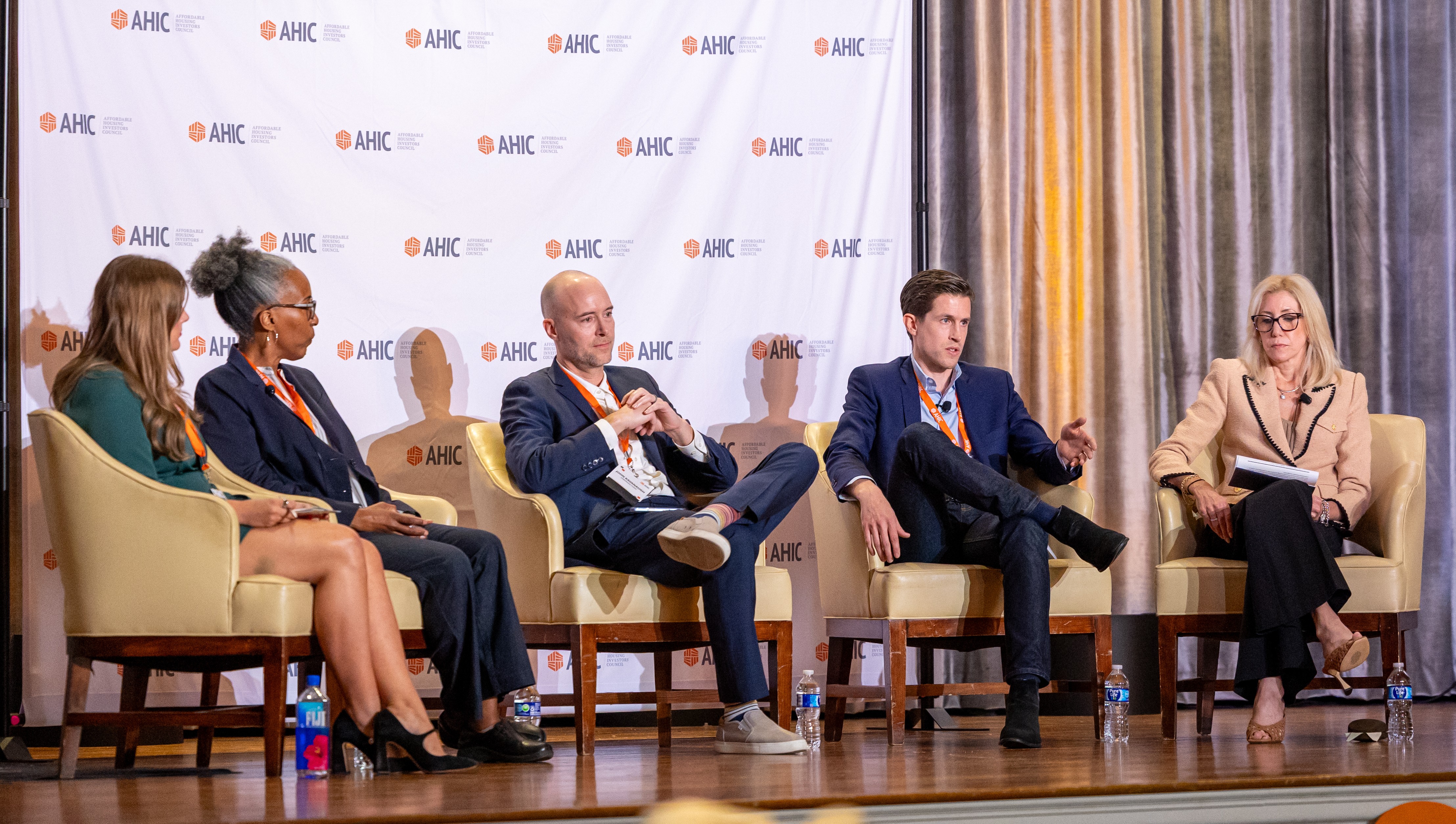Navigating Uncertainty: Investor Perspectives on the 2025 LIHTC Market
 In a wide-ranging discussion moderated by Julie Sharp of Merchants Capital, four major LIHTC investors shared their unfiltered views on navigating today's complex affordable housing landscape. The panel—featuring Desiree Francis (Capital One), John Kavanaugh (JPMorgan Chase), Susan Malysa (New York Life), and Scott Maxfield (Goldman Sachs)—tackled everything from government shutdowns to tariffs, offering valuable insights for the entire LIHTC ecosystem.
In a wide-ranging discussion moderated by Julie Sharp of Merchants Capital, four major LIHTC investors shared their unfiltered views on navigating today's complex affordable housing landscape. The panel—featuring Desiree Francis (Capital One), John Kavanaugh (JPMorgan Chase), Susan Malysa (New York Life), and Scott Maxfield (Goldman Sachs)—tackled everything from government shutdowns to tariffs, offering valuable insights for the entire LIHTC ecosystem.Government Uncertainty and Execution Risk
The timing of the session—day eight of a government shutdown—set the stage for a discussion about political risk. While panelists expressed confidence in bipartisan support for affordable housing, they acknowledged heightened concerns about execution risk, particularly around HUD approvals and Section 8 funding.
Malysa emphasized that New York Life is "approaching LIHTC investments with a heightened focus on execution risk" while continuing to rely on strong syndicator partnerships. The investors generally agreed that while HUD-related deals face potential delays, forward commitments from Fannie Mae and Freddie Mac remain largely unaffected.
On Section 8, the panel struck a cautiously optimistic tone. Francis noted that despite proposed cuts, Congress has consistently provided flat or increase Section 8 funding. However, she pointed to potential disruptions around eligibility requirements and benefit duration as areas of concern. The consensus: while stabilized deals with Section 8 contracts remain relatively secure, investors are conducting more rigorous sensitivity analyses—particularly for contracts paying above fair market rates—and exercising greater caution with deals featuring large Section 8 overhangs.
Tax Bill Impact: Short-Term Flux, Long-Term Optimism
The expansion of LIHTC allocations dominated much of the conversation, with panelists offering nuanced views on near-term market dynamics. Kavanaugh reported that JPMorgan has actually secured more deals in the three months since the tax bill passed than in the previous seven months—though he attributed this more to pricing expectations normalizing than directly to the legislation.
However, he identified several provisions beyond the credit expansion that could impact LIHTC demand: bonus depreciation and immediate R&D expensing may reduce overall tax liability, while the 2027 sunset on certain energy credits could create near-term competition for tax capacity before potentially opening up more room for LIHTC investments.
Maxfield highlighted the practical challenges ahead: the transition from 50% to 25% tax-exempt debt requirements will create immediate budget gaps. While this theoretically doubles the number of 9% deals possible, it also strains existing subsidy sources. He noted that it will take time for states to ramp up recycled bond programs, potentially requiring more expensive taxable debt in the interim. Combined with the likelihood of softer pricing due to increased supply, many deals will need additional subsidy to close.
Despite these headwinds, JPMorgan is on track for a record volume year and projects similar levels for 2026. Goldman Sachs maintains its commitment at around $2.5 billion annually in LIHTC, construction debt, and other tax credits. Capital One, having recently closed its acquisition of Discover, announced plans to increase affordable housing activity by $35 billion over five years across multiple products.
State and Local Innovation—and Complications
The panel devoted considerable attention to how state and local governments are responding to expanded federal credits. New York emerged as a case study in creative structuring. New York City plans to use escrow closings that break next year to qualify for the 25% test, while New York State is employing tranche closings—closing roughly 20% of bonds this year and reserving 5% for next year to meet federal requirements.
New Jersey's recently announced $500 million state credit auction drew particular interest. The auction will raise proceeds to fill budget gaps in deals, with the state providing a backstop to ensure minimum pricing—a mechanism designed to address liquidity concerns in the state credit market.
However, state and local policies aren't universally positive. The panel expressed elevated caution about markets like Washington D.C., Seattle, Portland, and San Francisco, where "generous renter policies" have led to portfolio challenges. While investors continue to work in these markets, they're applying heightened underwriting scrutiny and evaluating developer exposure more carefully.
Tariffs and Construction Costs: Managing the Unknown
On the construction front, investors have mobilized comprehensive strategies to address tariff impacts. Kavanaugh described JPMorgan's granular, line-by-line cost reviews, noting that actual impacts have been less severe than anticipated—likely due to material substitution and effective contractor management.
The consensus expectation is a "mid to high single digit" one-time cost increase, which negotiated construction contracts are spreading over time to make more absorbable. Investors are increasingly pushing tariff risk onto general contractors through cost escalation clauses—but with guardrails. These clauses are typically limited to materials (not labor or overhead), capped at specific dollar amounts, and paired with cost-savings provisions if tariffs don't materialize or decrease.
Notably, Maxfield highlighted that immigration policy concerns may ultimately prove more significant than tariffs for construction costs, particularly for garden-style and mid-rise developments in the Sun Belt and West Coast. However, no material labor cost increases have emerged yet, leaving this as a watch item rather than an immediate crisis.
GP Securitizations: Opportunity or Alignment Risk?
The emerging trend of GP interest securitizations sparked one of the session's most nuanced debates. These structures—where developers pledge 70-80% of general partner cash flow to raise immediate capital—are becoming more common as developers seek alternatives to asset sales in an unfavorable cap rate environment.
Maxfield acknowledged concerns about incentive alignment but argued these securitizations serve important functions: they provide developers with capital to fill budget gaps and maintain stronger balance sheets for guarantee requirements. Since they're non-recourse and lack real estate collateral, they don't technically increase project-level debt. Moreover, developers retain back-end residual interests, maintaining motivation to ensure long-term asset performance.
Others noted concerns about structures with mandatory monthly payments that could force asset sales during compliance periods. The consensus was that securitizations can be workable if structured carefully, but investors must closely evaluate sponsor incentives.
High Bar for New Syndicator Partnerships
When asked about onboarding new syndicators, panelists agreed that the bar is high. Investors are unlikely to bring on new syndicators unless they provide access to new markets, incremental deal flow, or specialized structuring expertise.
They also cited efficiency concerns. Duplicate bidding from multiple syndicators on the same deal was cited as a time-consuming inefficiency. Adding more partners without clear differentiation could create more work without adding value.
The investor panel underscored both the opportunities and headwinds facing the LIHTC industry in 2025 and beyond. While political uncertainty, tax capacity pressures, and construction challenges loom large, the long-term outlook remains resilient. Investors continue to see affordable housing as a durable, bipartisan priority—and they are prepared to adapt their underwriting, partnerships, and strategies to ensure continued delivery of high-quality, affordable homes.
